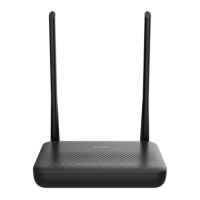It specifies the mode that you used to set up the WAN connection, including Bridged,
IPoE, PPPoE and 6rd.
⚫
Bridged: Select this type when this device only serves as a modem, and you want to
set up a dial-up connection or enter other internet parameters directly on your
computer for internet access.
⚫
IPoE: Select DHCP if your ISP does not provide any parameters to you for internet
access, and select Fixed IP if your ISP provides a static IP address and other related
information to you for internet access.
⚫
PPPoE: Select this type if your ISP provides a user name and password to you for
internet access.
⚫
6rd: Select this type when you want to deploy the IPv6 network rapidly based on
IPv4 infrastructures.
It specifies whether to enable the Network Address Port Translation (NAPT) function.
NAPT is a technique in which port numbers and private IP addresses are mapped from
multiple internal hosts to one public IP address and enable hosts within the LAN to
access the internet with the same public IP address. If multiple devices need to share
the WAN in the router mode, you need to enable NAPT.
It specifies whether to enable this WAN connection.
It specifies the WAN connection type. Choose the proper connection type as required
by your ISP.
⚫
Other
⚫
TR069
⚫
INTERNET
⚫
INTERNET_TR069
⚫
VOICE
⚫
VOICE_TR069
⚫
VOICE_INTERNET
⚫
VOICE_INTERNET_TR069
Maximum Transmission Unit (MTU) is the largest data packet transmitted by a network
device. When the channel mode is PPPoE, the default MTU value is 1492. When the
channel mode is IPoE, the default MTU value is 1500. Do not change the value unless
necessary.
It specifies whether to enable the Internet Group Management Protocol (IGMP) Proxy.
If you are not sure, keep the default setting or consult your ISP.
IGMP Proxy is used to manage multicast data and reduce traffic replication. IGMP
proxy enables a device to issue IGMP host messages on behalf of its users, reducing
IGMP messages and the load for the uplink device.
It specifies whether to enable the Multicast Listener Discovery (MLD) Proxy. If you are
not sure, keep the default setting or consult your ISP.
MLD is the IPv6 equivalent of IGMP.
It specifies the adopted IP protocol version.
⚫
IPv4: Select this option if IPv4 is used for communication.
⚫
IPv6: Select this option if IPv6 is used for communication.
⚫
IPv4/IPv6: Select this option if both IPv4 and IPv6 are used for communication.

